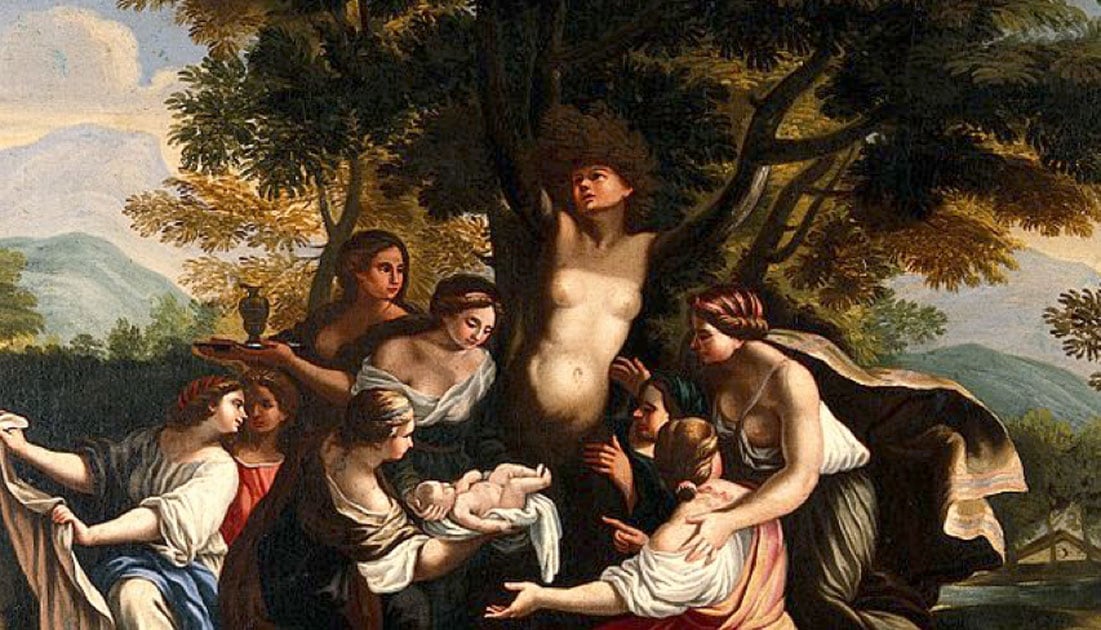From Incest to Incense: The Sad and Sordid Affair of Myrrha’s Punishment by Aphrodite
One of the most disturbing stories in the Greek mythological canon has ties to some of the most important figures on Olympus. The multi-generational madness of the royal family of Cyprus includes Aphrodite’s true love and even ties to the birth story of Jesus!
When Myrrha Angered Aphrodite
Meet Myrrha (also known as Smyrna), daughter of King Cinyras of Cyprus, a monarch known all the way back to the Iliad. Cinyras reportedly came to the throne via his wife, Pharnace, daughter of the Cypriot king Pygmalion. Their best-known kid was their little girl, Myrrha. The story goes that Myrrha was a nice young woman, but she made a particularly nasty mistake: She didn’t honor the goddess of love, Aphrodite.
The deity got her revenge by making Myrrha fall in love after all—but with the most inappropriate person possible: her dad! Myrrha burned from the inside out with her passion. Ovid claims that caring Cinyras asked Myrrha what kind of husband she would like; overcome with love for her dad, she stared at him and said, “One just like you.” He thought she was just being a good daughter, but little did he know…
- Why Did Ancient People Travel Thousands of Kilometers for Incense?
- More than a Goddess of Love: The Many Other Aspects of Aphrodite
- The Seductive Sirens of Greek Mythology: How the Heroes Resisted Temptation

“Cinyre, prêtre de Vénus, et Myrrha” (Cinyre, priest of Venus, and Myrrha). (Public Domain)
Driven crazy by desire, Myrrha almost hung herself before her childhood nanny walked in on her suicide attempt. The old lady decided to help Myrrha get her man, no matter the cost. Thankfully, there was an important festival coming up celebrating Demeter, in which married women couldn’t sleep with their husbands. Therefore, Cinyras couldn’t be with his wife; when his daughter’s nurse came to him and told him about a pretty young girl who had a crush on him, Cinyras was into it. He got drunk and was tricked into sleeping with her for twelve straight nights, so he didn’t realize who he was sleeping with…

Myrrha and Cinyras. Engraving by Virgil Solis for Ovid's Metamorphoses Book X, 298-475. (Public Domain)
The Ruse is Revealed
Cinyras only realized his crime after he woke up sober one morning. Seeing his daughter in his bed and realizing what he had done, he was horrified and tried to right his wrong by killing Myrrha. He chased her for nine months; but she fled all the way to Arabia. When she couldn’t run anymore, Myrrha prayed to the very gods she had once wronged to help her out: to make her invisible from her tormentor—or, alternatively, change her bodily form. The Olympians took pity on her, turning Myrrha into a myrrh tree (the valuable substance is often translated into Greek as Smyrna, her other name). And, of course, myrrh was one of the gifts the Magi gave baby Jesus in the Gospel of Matthew.
Nine months later, a boar ran into the myrrh tree and cracked the bark with its tusk. To the boar’s surprise, a baby popped out. It turns out Myrrha was pregnant by her own dad when she metamorphosed. Aphrodite, whom his mother had abhorred and whose curse created the child, ironically fell in love with the youngster. Ovid says that her son, Eros, accidentally cut his mom with one of his magic arrows and made her fall for the baby, named Adonis. Whether because she was embarrassed by her feelings for young Adonis or because she was trying to hide the consequences of her curse, Aphrodite hid the baby in a chest and gave him to Persephone, daughter of Demeter, wife of Hades and queen of the Underworld, to raise.
- The Appealing Adonis Who Enthralled Many Ancient Civilizations
- Frankincense may infuse users with mild euphoria
- Phryne, The Ancient Greek Prostitute Who Flashed Her Way to Freedom

‘Birth of Adonis’ (c. 1685-90) by Marcantonio Franceschini. (Public Domain) Myrrha’s baby was Adonis.
What Became of Myrrha’s Child?
Once childless Persephone saw the baby, she fell head-over-heels for him and refused to give him back. She and Aphrodite went to court before Zeus over custody and the king of the gods ruled that Adonis would spend a third of the year with each mother figure, then the final third by himself (rather similar to the way Persephone was sentenced to some life with Hades and some life on Earth with her mother). Adonis apparently wanted to spend more time with Aphrodite, as he decided to spend his solo months with her.

‘Venus and Adonis’ (c. 1587) by Bartholomeus Spranger. (Public Domain)
Adonis grew into a handsome young man, but tragedy struck eventually. He went hunting, as hotties did, and was gored by a wild boar then bled to death. Sad! Rumor had it that the boar was Aphrodite’s longtime lover, the god Ares, or her husband, Hephaestus, in disguise; one of these dudes allegedly killed his lady’s guy on the side out of jealousy. In sorrow, Aphrodite created a flower, the anemone, from the blood Adonis shed on the spot.

Vénus pleurant la mort d'Adonis (Venus mourning the death of Adonis) (1753) by Jean-Faur Courrège. (Public Domain)
Top Image: Detail of ‘The birth of Adonis and the transformation of Myrrha.’ By Luigi Garzi. Source: Wellcome Images/CC BY 4.0
By Carly Silver
Bibliography
Apollodorus. The Library. Translated by Sir James George Frazer. New York: G.P. Putnam’s Sons, 1921.
Chomsky, Noam. Lectures on Government and Binding: The Pisa Lectures. Berlin: Walter de Gruyter, 1993.
Grant, Michael, and John Hazel. Who's Who in Classical Mythology. New York: Routledge, 2002.
Homer. The Iliad. Translated by Alexander Pope. London: G. Routledge, 1848.
Ovid. Metamorphoses. Translated by Brookes More. Brookes. Boston: Cornhill Publishing Co., 1922.

















